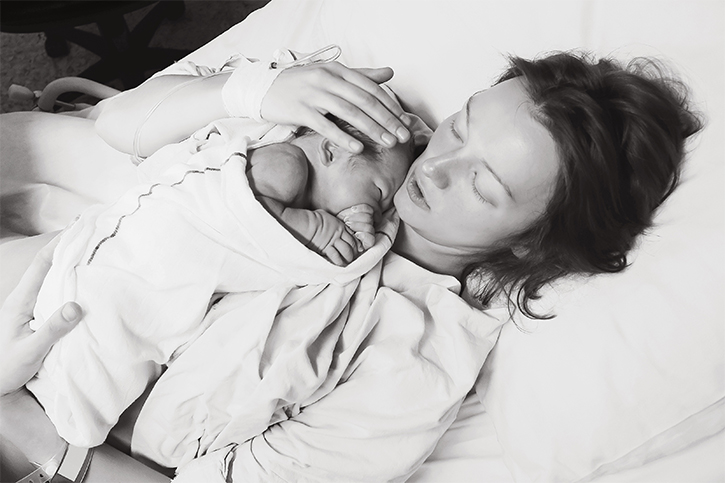Not every birth will go to plan. You may even find yourself in a situation where the safest option for you and your baby is to deliver by caesarean birth. Every woman’s birth experience is different. And whether a caesarean birth is planned or unplanned, it is no better or worse than any other birthing method.

In some circumstances, you may require a caesarean birth to make sure you and your baby are safe. Let’s take a look at why you might need one and what happens during the procedure.
Pregnancy is a time of changes, both emotional and physical. After going through multiple changes throughout your three trimesters, there may be various reasons why your obstetrician might decide with you, that a caesarean is the best choice.
A caesarean birth may be planned or unplanned. Regardless of the circumstances, it is just as valid and exerting as a vaginal delivery. Here is what you need to know about caesarean birth.
During your pregnancy, your obstetrician will advise on the options available for birth plans. What you choose will depend on your personal preferences but remember, circumstances may change, so keep an open mind.
What Is A Caesarean Section?
A caesarean section is also known as a C-section in America. It is the surgical procedure used to deliver your baby or babies. This procedure is usually performed by an obstetrician who makes an incision in your tummy and uterus (womb), to deliver your baby.
C-sections are often performed when a vaginal delivery is deemed too risky for either a mother or baby. While it is advised to only have a caesarean when medically appropriate, some are performed on the request of mothers. Nearly one third of Australian women giving birth via C-section every year.
Caesareans are a safe, but major surgery. Risks involved in this type of surgery include:
• Blood loss
• Blood clots
• Infection
• Complications with anaesthetic
• Problems with future birth attempts
Why Might I Need A Caesarean?
There are various reasons you may need a caesarean. Caesareans are classified as being elective (planned) or emergency (unplanned).
An elective caesarean means the procedure is planned before the start of labour. The most common reasons for this type of C-section include:
• You have had a caesarean before
• Your baby is in the breech position with their bottom or feet first
• Your baby is lying sideways (transverse)
• You are carrying two or more babies
• Issues with the placenta (such as placenta previa) or umbilical cord
An emergency caesarean is an unplanned caesarean procedure. This can occur when:
• Your labour is stalled or not progressing
• You have high blood pressure
• Your baby’s head will not progress through your pelvis
• The umbilical cord prolapses
• There are concerns for your baby’s health and wellbeing (such as an abnormal heart rate)
• You or your baby experience a serious complication
What Happens During A Caesarean?
A caesarean procedure usually takes up to one hour. During this time, your partner will often be allowed in the room with you. There are some instances where you might be put to sleep for your baby’s birth with a general anaesthetic. But in most caesarean births, regional anaesthesia is used because general anaesthesia can anaesthetise your baby as well as you.
Regional anaesthesia means you will be awake during the procedure. You will feel pressure in your abdomen, but not pain. The main types of anaesthetic given in this instance are:
• Spinal anaesthetic
• Epidural anaesthetic
• Combined spinal and epidural anaesthetic
A caesarean is performed by a doctor who makes a cut in your abdomen and uterus to lift your baby out of. Often forceps will be used to gently assist your baby. Shortly after the birth, you will be able to touch your new bundle of joy. This is the quick part of your procedure, and usually takes less than ten minutes from starting the operation.
Your umbilical cord will be cut, and your placenta will be removed from your body after a caesarean birth. You will also have your muscle, fat and skin stitched together and a dressing applied. This is the slow part of the procedure, and can take more than 40 minutes. Antibiotics will be prescribed to reduce the risk of infection after a C-section.
Recovery from Caesarean Birth
After a giving birth via caesarean, you will usually stay in hospital for three to five days. Recovery for this type of birth can take longer than vaginal delivery. You may need to continue taking antibiotics or pain relief as advised by your doctor.
You may experience some bleeding and/or discharge (lochia) from the vagina after giving birth. This is completely normal and occurs with all births (caesarean or otherwise).
Once you are home and settled with your baby, avoid lifting heavy objects for at least two weeks. Keep your wound clean and only undertake light walking for exercise. You should also avoid sex until you feel comfortable. Once your wound is healed, the scar may be numb or itchy. This is completely normal.
Your body goes through a lot for a caesarean birth, so it is important you be kind to yourself. The post-partum period can be an amazing and challenging time. Every new mum will recover at a different pace and experience different feelings after a C-section. Be sure to talk through any feelings you are concerned by with a loved one or health professional.
If you have any questions regarding pregnancy or caesareans, please don’t hesitate to get in touch.
Dr Brown is one the most trusted gynaecologists and obstetricians in Sydney and will strive to provide advice and compassionate care in every way possible.
